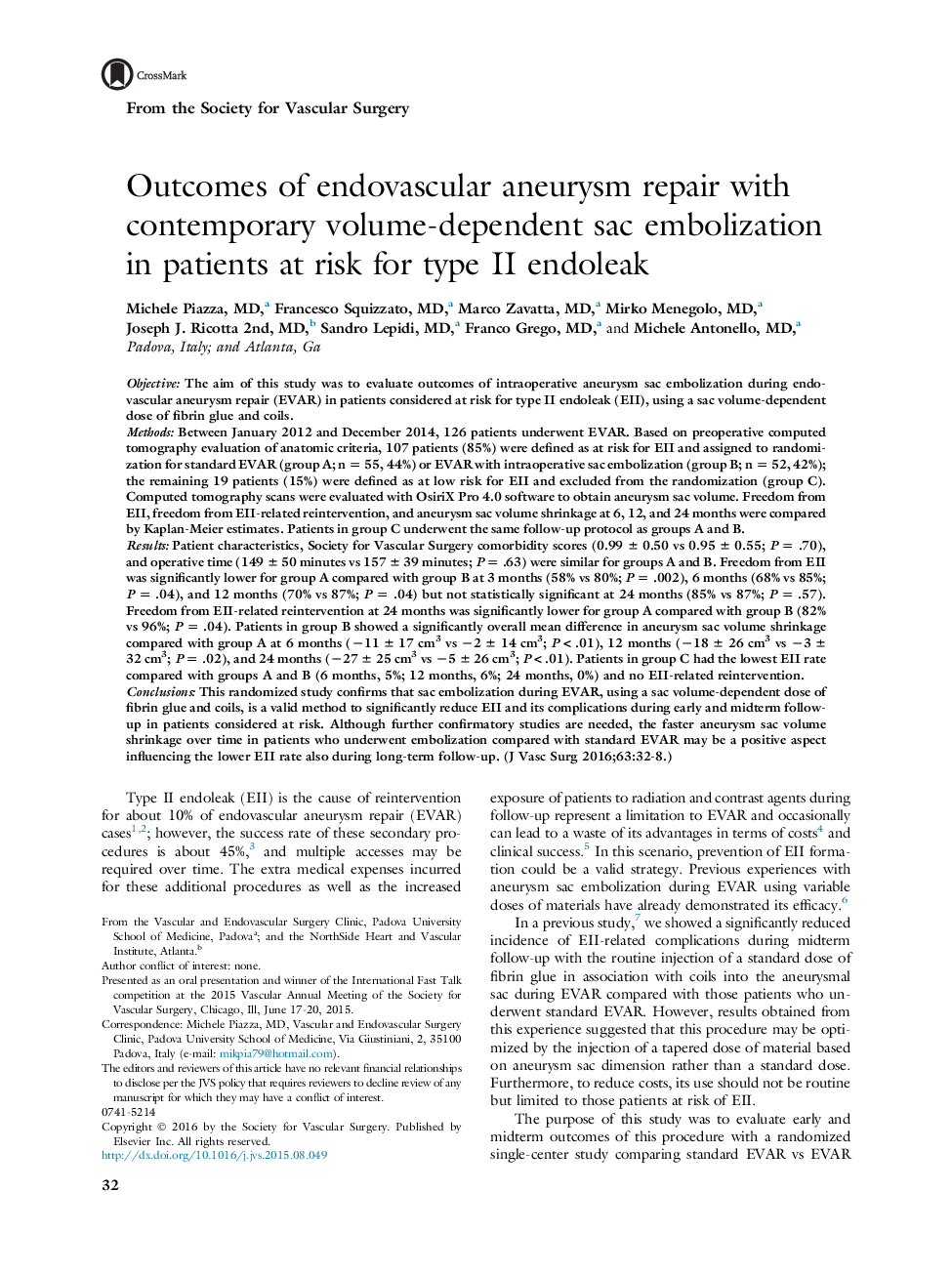| کد مقاله | کد نشریه | سال انتشار | مقاله انگلیسی | نسخه تمام متن |
|---|---|---|---|---|
| 2987921 | 1179810 | 2016 | 7 صفحه PDF | دانلود رایگان |

ObjectiveThe aim of this study was to evaluate outcomes of intraoperative aneurysm sac embolization during endovascular aneurysm repair (EVAR) in patients considered at risk for type II endoleak (EII), using a sac volume-dependent dose of fibrin glue and coils.MethodsBetween January 2012 and December 2014, 126 patients underwent EVAR. Based on preoperative computed tomography evaluation of anatomic criteria, 107 patients (85%) were defined as at risk for EII and assigned to randomization for standard EVAR (group A; n = 55, 44%) or EVAR with intraoperative sac embolization (group B; n = 52, 42%); the remaining 19 patients (15%) were defined as at low risk for EII and excluded from the randomization (group C). Computed tomography scans were evaluated with OsiriX Pro 4.0 software to obtain aneurysm sac volume. Freedom from EII, freedom from EII-related reintervention, and aneurysm sac volume shrinkage at 6, 12, and 24 months were compared by Kaplan-Meier estimates. Patients in group C underwent the same follow-up protocol as groups A and B.ResultsPatient characteristics, Society for Vascular Surgery comorbidity scores (0.99 ± 0.50 vs 0.95 ± 0.55; P = .70), and operative time (149 ± 50 minutes vs 157 ± 39 minutes; P = .63) were similar for groups A and B. Freedom from EII was significantly lower for group A compared with group B at 3 months (58% vs 80%; P = .002), 6 months (68% vs 85%; P = .04), and 12 months (70% vs 87%; P = .04) but not statistically significant at 24 months (85% vs 87%; P = .57). Freedom from EII-related reintervention at 24 months was significantly lower for group A compared with group B (82% vs 96%; P = .04). Patients in group B showed a significantly overall mean difference in aneurysm sac volume shrinkage compared with group A at 6 months (−11 ± 17 cm3 vs −2 ± 14 cm3; P < .01), 12 months (−18 ± 26 cm3 vs −3 ± 32 cm3; P = .02), and 24 months (−27 ± 25 cm3 vs −5 ± 26 cm3; P < .01). Patients in group C had the lowest EII rate compared with groups A and B (6 months, 5%; 12 months, 6%; 24 months, 0%) and no EII-related reintervention.ConclusionsThis randomized study confirms that sac embolization during EVAR, using a sac volume-dependent dose of fibrin glue and coils, is a valid method to significantly reduce EII and its complications during early and midterm follow-up in patients considered at risk. Although further confirmatory studies are needed, the faster aneurysm sac volume shrinkage over time in patients who underwent embolization compared with standard EVAR may be a positive aspect influencing the lower EII rate also during long-term follow-up.
Journal: Journal of Vascular Surgery - Volume 63, Issue 1, January 2016, Pages 32–38